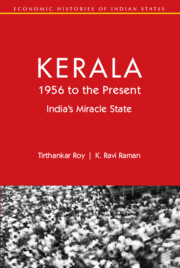Book contents
4 - Capital: Retreat and Resurgence
Published online by Cambridge University Press: 31 May 2024
Summary
When India became independent, the main livelihoods in this region, as in the rest of the country, were based on land. But unlike most other regions of India, a significant and relatively more prominent part of the economy (half or more of the domestic product) was urban and non-agricultural. Non-agricultural did not mean industrial. True, the processing of some commercial products involved non-mechanised factories. Alappuzha (Alleppey) had emerged as a hub of coir production and Quilon (Kollam) of cashew. Some isolated large, mechanised factories employed hundreds of people in one place in chemicals, rayon, paper and a few other lines. Thus, Aluva (Alwaye) had textiles, fertilisers, aluminium, glass and rayon industries, and Ernakulam oil and soap industries. There were also tea estates in the hills. A concentration of plantation businesses in rubber and spices occurred to the east of Kottayam. But collectively, these formed a smaller group than trade and the financing of marketing, which dominated the landscape of non-agricultural employment. All major towns lived mainly on trade and informal banking. Trichur and Kottayam were mostly service-based towns, with a concentration of banks, colleges and rich churches.
Over one-third of the workforce was in industry, trade, commerce and finance. In most large states of India, the percentage was 20–35. The exceptions were the industrialised states of West Bengal and Maharashtra, where factory-based large-scale industrial firms concentrated. Again, a contrast emerged with the rest of India. Most local businesses were small-scale, semi-rural and household enterprises, whereas non-agricultural enterprises in the rest of India were mainly urban.
Further, industrialisation almost everywhere else signified a sharp inequality between the countryside and the city. The former was trapped in low-yield farmland producing grains for subsistence or local markets, and the latter experienced growth of high-wage jobs. In the state, that distance was narrower. The presence of tree crops and their industrial processing made for a narrower gap between the rural and the urban. Many of the landholders were also owners of estates growing tree crops. Agriculture was not necessarily low yield nor subsistence oriented. In this way, agriculture and non-agriculture, rural and urban came much closer here compared with India.
- Type
- Chapter
- Information
- Kerala, 1956 to the PresentIndia's Miracle State, pp. 56 - 81Publisher: Cambridge University PressPrint publication year: 2024

